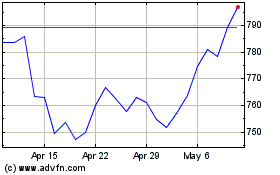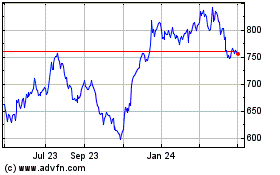By Sarah Krouse and Austen Hufford
Assets at the world's largest money manager topped $5 trillion
for the first time by the end of the third quarter as investors
continued to pour billions into lower-cost index-tracking
funds.
BlackRock Inc. said Tuesday that it had $5.12 trillion in assets
under management, up 14% from a year earlier. Profit for the New
York firm rose, but revenue fell as performance fees decreased.
BlackRock's flows during the quarter highlight an ongoing shift
in investor taste for lower-cost passive funds that track the
performance of indexes. Roughly 93% of BlackRock's $55 billion in
long-term net inflows during the third quarter came from its
iShares exchange-traded fund unit.
Those changing industry flows have been a source of pain for
firms that have long specialized in hand-picking winning stocks and
bonds.
"We believe the utilization of ETFs is going to continue to
grow," Chief Executive Laurence Fink said in an interview, adding
that he expects greater use of the products by active managers and
of bond ETFs broadly.
The iShares business, which comprises about a quarter of
BlackRock's assets under management, pulled in net new money across
all asset classes. Meanwhile investors pulled a net $7.8 billion
from BlackRock's actively managed equity strategies. The firm's
active bond strategies attracted a net $10.2 billion during the
quarter.
Still, the growing popularity of passive over active products
was one of several factors that contributed to BlackRock's slight
year-on-year revenue decline, Mr. Fink said. Revenue fell 2.5% to
$2.84 billion in the third quarter. Other factors included
continued client uncertainty, a large performance fee during the
same quarter a year earlier, and currency movements associated with
the U.K.'s June decision to leave the European Union, he said.
BlackRock's own active funds haven't been immune from the
performance challenges traditional money managers have faced.
Half of the firm's traditional actively managed stock funds
underperformed their benchmark or peers over one year at the end of
September, up from 20% a year ago. Over three years 34% were
underperforming, down from 42% at the same time last year.
Among the firm's quantitative "scientific active equity" funds,
69% underperformed their benchmark or peer group over the year to
the end of September, a large increase from 3% of those funds
during the same period last year. Meanwhile, over three years, 17%
were underperforming, up from 3% at the end of the third quarter of
2015.
Some of those funds, Mr. Fink said, were hurt by incorrect bets
on the outcome of the Brexit vote and on the health of the Japanese
economy.
Active managers broadly continue to be challenged by central
banks, he added.
"Everything is more correlated than ever before. I think that's
the biggest issue facing the active industry," Mr. Fink said,
adding that the firm hadn't given up on active management. "Once we
see a change in behavior by central banks, you probably have a
higher opportunity to make active returns."
BlackRock has benefited in recent years, analysts say, from its
broader mix of businesses than many of its rivals. In addition to
active and passive funds, for example, BlackRock also sells a
investment and risk-management technology.
"We continue to believe that size, a diverse product lineup and
a strong ETF business are the ingredients to success for asset
managers in this challenging environment," Edward Jones analysts
said in a note Tuesday. "In our view, BlackRock is one of the few
asset managers that fit this profile."
Total net inflows at BlackRock, including cash management,
totaled $69.8 billion in the third quarter.
The firm's path to $5 trillion began in 1988, when the firm
started as a fixed-income specialist as part of Blackstone Group in
a single Park Avenue office. By 1999, when the money manager went
public, it had gathered $165 billion in assets.
A series of canny deals in the mid- to late-2000s added to its
heft and its mix of businesses. The firm bought Merrill Lynch
Investment Managers in 2006, a transaction that helped it expand
globally and bolster its stock picking and multiasset businesses.
The deal boosted BlackRock's assets under management to about $1
trillion for the first time.
Then, in 2009 with $1.3 trillion in assets, it acquired Barclays
Global Investors, gaining a large exchange-traded fund business
that helped it turn iShares into the world's largest ETF business.
Assets under management more than doubled to more than $2.7
trillion as a result of the deal.
Since then, the firm has worked to grow that passive-investing
unit, gather assets globally, bolster its alternatives platform and
gain more retail assets. It passed the $4 trillion mark in late
2013.
In all, BlackRock reported a profit of $875 million in the third
quarter, up from $843 million a year prior. Per-share earnings grew
to $5.26 from $5. Excluding certain items, BlackRock earned $5.14 a
share.
Revenue fell 2.5% to $2.84 billion.
Analysts had projected $5 a share in adjusted earnings on $2.88
billion in revenue, according to Thomson Reuters.
BlackRock shares, down 0.9% in the past three months, rose 0.4%
in morning trading.
Write to Sarah Krouse at sarah.krouse@wsj.com and Austen Hufford
at austen.hufford@wsj.com
(END) Dow Jones Newswires
October 18, 2016 10:22 ET (14:22 GMT)
Copyright (c) 2016 Dow Jones & Company, Inc.
BlackRock (NYSE:BLK)
Historical Stock Chart
From Mar 2024 to Apr 2024

BlackRock (NYSE:BLK)
Historical Stock Chart
From Apr 2023 to Apr 2024
